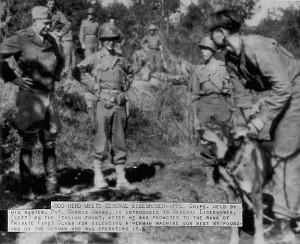This Week in US Military History

Mar. 11
1862: President Abraham Lincoln fires Gen. George B. McClellan from his post as general-in-chief due to McClellan’s unwillingness to attack the Confederate army.
1918: Lt. Paul Baer singlehandedly attacks seven German aircraft over Cerney-les-Reims, France, shooting down one and becoming the Army Air Corps’ first Distinguished Service Cross recipient. Baer would ultimately become an ace, splashing nine enemy aircraft during World War I.
1941: The United States becomes an “arsenal of democracy” when President Franklin D. Roosevelt signs the Lend-Lease Act. The program provided over $50 billion in funds, weapons, aircraft, and ships to allied nations.
1945: B-29 Stratofortress bombers conduct a strategic bombing campaign against mainland Japan. Within a week, Osaka, Kobe, and Nagoya go up in flames. 120,000 Japanese civilians die at the cost of only 20 B-29s lost.
1965: The U.S. Navy conducts the first patrols of Operation MARKET TIME. The blockade lasted eight-and-a-half years and effectively blocked enemy troops and supplies from reaching South Vietnam by sea.
Mar. 12
1942: Four PT boats transport Gen. Douglas MacArthur, his family, and staff from the Philippine island fortress of Corregidor to Australia.
Mar. 13
1865: The Confederate government approves the use of slaves for soldiers. Although Gen. Robert E. Lee requested that slaves who fought should be granted freedom, the bill did not allow such a provision. Several thousands slaves would go on to fight for the Confederacy. 200,000 blacks fought for the Union.
1942: The U.S. Army Quartermaster Corps begins training dogs for it’s “K-9 Corps.” Following basic training, the dogs were utilized in sentry, scout, messenger, and mine detection duties.
Mar. 14
1951: United Nations forces under the command of U.S. Army Gen. Matthew B. Ridgway recapture Seoul, Korea.
1965: U.S. and South Vietnamese forces launch the second bombing wave of Operation ROLLING THUNDER, targeting facilities on Tiger Island, off the North Vietnamese coast, and the ammunition depot at Phu Qui, 100 miles south of Hanoi.
Mar. 15
1781: British Army forces under the command of Lt. Gen. Charles Cornwallis march toward a pyrrhic victory over Continental Army and militia forces commanded by Maj. Gen. Nathaniel Greene at Guilford Courthouse (near present-day Greensboro), N.C.
1916: As World War I rages in Europe, a U.S. Army expeditionary force under the command of Gen. John J. “Black Jack” Pershing crosses into Mexico in pursuit of the bandit, Pancho Villa.
Mar. 16
1802: President Thomas Jefferson signs into law the establishment of a corps of engineers, which “shall be stationed at West Point in the State of New York and shall constitute a Military Academy.” The United States Military Academy is born.
1916: Following Mexican bandit Pancho Villa’s raid on Columbia, New Mexico, the U.S. Army Signal Corps’ 1st Aero Squadron conducts the first military aerial reconnaissance flight over Mexico.
1945: Though Japanese resistance will continue for several more days, Iwo Jima is declared secure.
1966: Neil A. Armstrong (USN, ret.) and David R. Scott (USAF) rocket into space aboard Gemini VIII, conducting the first docking operation in space. Gemini VIII suffered the first critical in-space system failure and had to abort the remainder of the mission, splashing down safely in the Pacific Ocean.
1988: When forces from Nicaragua’s leftist government crossed into Honduras to strike Contra rebel targets, President Ronald Reagan deploys 3,000 U.S. troops to Honduras.
Mar. 17
1776: British forces under the command of Gen. Sir William Howe begin evacuating Boston after Howe reluctantly concludes that the American artillery positions atop Boston’s commanding Dorchester Heights are “impregnable.”
1973: The first U.S. prisoners of war are released from the infamous “Hanoi Hilton” prison camp in North Vietnam.
Find history for other dates at the Center for American Military History
Adapted (and abridged) in part from “This Week in US Military History” by W. Thomas Smith Jr. at Human Events.